
Sylhet Division is the northeastern division of Bangladesh. It is bordered by the Indian states of Meghalaya, Assam and Tripura to the north, east and south respectively, and by the Bangladeshi divisions of Chittagong to the southwest and Dhaka and Mymensingh to the west. Prior to 1947, it included the subdivision of Karimganj. However, Karimganj was inexplicably severed from Sylhet by the Radcliffe Boundary Commission. According to Niharranjan Ray, it was partly due to a plea from a delegation led by Abdul Matlib Mazumdar.

Sylhet is a metropolitan city located in the northeastern region of Bangladesh. It is the administrative center of Sylhet Division. It is situated on the banks of the Surma River and is surrounded by the Kurirgoan, Kunachar, and Miajaner Gaon. The city has a population of approximately 700,000 people, making it the fifth-largest city in Bangladesh.

Habiganj, formerly known as Habibganj, is a district in north-eastern Bangladesh, located in the Sylhet Division. It was established as a district in 1984 as a successor to its subdivision status since 1867. It is named after its headquarters, the town of Habiganj.
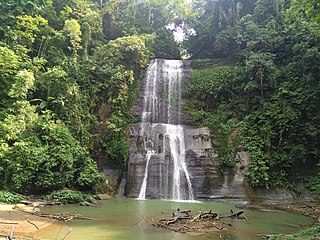
Moulvibazar also spelled Maulvibazar, Moulavibazar, and Maulavibazar, is the southeastern district of Sylhet Division in northeastern Bangladesh, named after the town of Moulvibazar. It is bordered by the Indian states of Tripura and Assam to the south and east, respectively; and by the Bangladeshi districts of Habiganj to the west and Sylhet to the north.
Chunarughat is an Upazila of Habiganj District in the Division of Sylhet, Bangladesh.
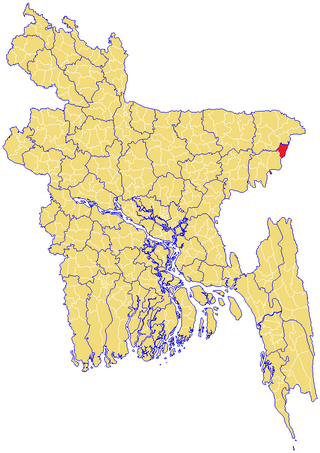
Barlekha is an upazila (sub-district) of Moulvibazar District, located in Bangladesh's Sylhet Division.

Kulaura is the biggest upazila (subdistrict) of the Moulvibazar District in north-eastern Bangladesh. The total area of this upazila is 545 km2. Hakaluki Haor, the largest marsh wetland in Sylhet and one of the largest in Bangladesh is partially located there.

Sreemangal is an upazila of Moulvibazar District in the Sylhet Division of Bangladesh. It is located at the southwest of the district, and borders the Habiganj District to the west and the Indian state of Tripura to the south. Sreemangal is often referred to as the 'tea capital' of Bangladesh, and is most famous for its tea fields. Other than tea, the rubber, pineapple, wood, betel, and lemon industries also exist in the upazila.
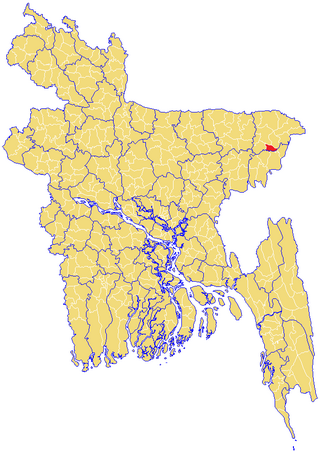
Fenchuganj is an upazila of Sylhet District in the Division of Sylhet, Bangladesh.
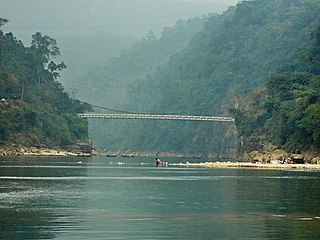
Jaflong is a hill station and tourist destination in the Division of Sylhet, Bangladesh. It is located in Gowainghat Upazila of Sylhet District and situated at the border between Bangladesh and the Indian state of Meghalaya, overshadowed by subtropical mountains and rainforests. It is known for its stone collections and is home of the Khasi tribe.

The Prithimpassa family, also known as the Nawabs of Longla, are an Shia royal family from the Prithimpassa Union, Kulaura Upazila, Moulvibazar, Sylhet, Bangladesh. The family was of the erstwhile feudal nobility of East Bengal. They played important roles in the Indian Rebellion of 1857, the Partition of India and Sylhet referendum in 1947, and the Bangladesh Liberation War of 1971.
The Sylheti or Sylhetis are an Indo-Aryan ethnocultural group that are associated with the Sylhet region in South Asia, presently divided between the Sylhet Division of Bangladesh, and the Barak Valley of Assam, India. There are sizeable Sylheti populations in Hojai district of Assam, the Indian areas of Meghalaya, North Tripura and Manipur's Jiribam district. They speak Sylheti, an Eastern Indo-Aryan language, which is ambiguously considered as an independent language, or as a dialect of Bengali.
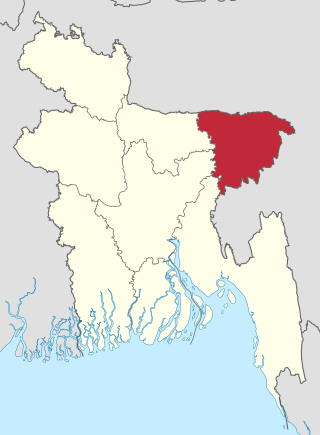
The economy of Sylhet is the 5th largest in the Peoples Republic of Bangladesh. It has a gross state product of $16 billion in nominal terms, and $40 billion in terms of purchasing power parity, making it the third largest behind Dhaka, Chittagong, Khulna and Rajshahi. Since the formation of Bangladesh, Sylhet has been regarded as the spiritual and cultural center of the country, and often termed as the agricultural capital of Bangladesh. Due to vast natural resources and emerging metropolitan, Sylhet is a major economic hub of the country alongside Dhaka and Chittagong. In recent years, Sylhet is experiencing major infrastructural developments, and projected to be the forefront of Bangladesh's economic growth. Sylhet is known for its tea plantations. About 80% of the country's agar processing factories are located in Barlekha Upazila.

Bangladesh is an important tea-producing country. It is the 12th largest tea producer in the world. Its tea industry dates back to British rule, when the East India Company initiated the tea trade in the hills of the Sylhet region. In addition to that, tea cultivation was introduced to Greater Chittagong in 1840. Today, the country has 166 commercial tea estates, including many of the world's largest working plantations. The industry accounts for 3% of global tea production, and employs more than 4 million people.

Seven-colour tea or seven-layer tea is a Bangladeshi beverage comprising layers of different teas. Tea is made in multiple permutations of concentration, tea leaf variety and adjuncts such as milk, sugar and flavourings and when combined separates according to density. Each layer contrasts in colour and taste, ranging from syrupy sweet to spicy clove. The result is an alternating dark/light band pattern throughout the drink, giving the tea its name.

Syed Abdul Majid, CIE, also known by his nickname Kaptan Miah, was a politician, lawyer and entrepreneur. He is notable for pioneering the development in the agricultural and tea industry in British India as well as his contributions to both secular and Islamic education in Sylhet.

The Mazumders of Sylhet, or more specifically, the Mazumders of Gorduar/Barshala, are a notable aristocratic family who have played important roles throughout the history of the Sylhet region.
Sreemangal Tea Auction Center is the second tea auction center in Bangladesh, which is located in Sreemangal Upazila, Moulvibazar District. It was inaugurated by Abul Maal Abdul Muhith, the Finance Minister of Bangladesh on 8 December 2017.
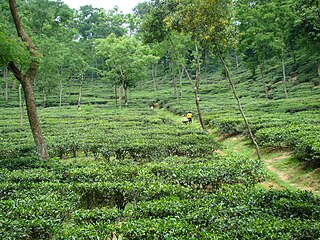
Harong Hurong is the name of an ancient cave in the Sylhet region of Bangladesh. The word Harong Hurong are the two dialects of two ancient Sylheti word. In Sylheti language, the word 'harong' means narrow or alternative route, and 'hurang' means 'tunnel'. That is, the word 'harong hurong' refers to the alternative tunnel way. There is a legend that, in 1303, when the king of Gour Govinda heard the news of Shahjalal's arrival in the region, he along with his army fled through the tunnel and was missing forever.
James Leo Ferguson, commonly known by the nickname Nanka, is a Bangladeshi politician, tea industrialist, and freedom fighter. He is the owner of Lobhachhara Tea Estate. Ferguson was elected as a people's representative after the liberation of Bangladesh. From 1976 to 1993, for a stretch of 17 years, he was the chairman of Lakshmiprasad Union, Kanaighat, Sylhet.















